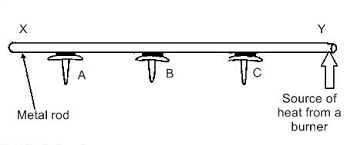Hey, Heat in science is a form of energy that causes an object to rise in temperature. This can form and modify many objects. Some objects won’t have reactions. Heat is what keeps us warm during winter or low tempurature activities.
For this term in science, we’ve been demonstrating several experiments involving heat.
Conduction
For conduction, we’ve done an experiment which is something like “pin dropping”
What we’ve done and practiced were to apply pins to a rod using vaseline, mark down the time each pin has drops. Here is the data
Pin 1 – 0.1 second
Pin 2 – 5 seconds
Pin 3 – 18 seconds
Pin 4 – 33 seconds
Pin 5 – 48 seconds
Review- Pins fell quite faster than expected. Vaseline had melted and dripped down. Longest estimated pin – Pin 4.
Theory- through observation. I genuinely think that the closer the pins are to the edge, the faster the pin will fall, As the rod is being heated, the rod particles will vibrate more and more, therefore making the pins on the surface of the rod fall down to the ground

This proves that the heat from our experiment can change properties of certain objects.
Or the heat may affect how fast objects can fall.
Contraction 30/06/2022
The experiment we’ve done for contraction is “imploding can”
Have a soda can with water filled in. Heat the soda can for a few minutes, have an empty icecream contrainer filled with low tempurature water, quickly hold grasp onto the can using tongs when ready, turn the can and put it into the icecream container as quick as possible.
Expecting reaction – A loud bang with a scrunched up soda can
The reaction: The imploding can loudly vibrated and scrunched in a split second.
Explanation: the heat particles diffused in the water with the cold water. The reason why we have earned that reaction is due to the speed of how we rotated the can in quickly. If we just poured the water, there would be gas, although, the an will cool down and won’t have the scrunching reaction.
What was happening to the water on the bunsen burner? The water in the can is being boiled off due to the hot temperature of the heat.
Honestly, It reminded me of one stranger things episode where Eleven crunched the can using her telekinesis skills

What this proves is that, the heat when transferred to cold quickly to objects, they may react in certain ways. Like glass cups, they’ll break, and according to our soda can experiment, our soda can explodes.
Convection experiment 1/07/2022
Referring to convection, we’ve been set to demonstrate an experiment focusing on this explored topic.
Using a bunsen burner and a beaker of 150ml of water, we’ve been instructed to gather one straw and a small sized potassium permanganate, or we can say crystal. The crystal, alias potassium permanganate, has to be the size of the opening of the straw.
Placing the straw into the beaker, gently pushing in the crystal, we turn the bunsen burner on, and the reaction will occur
As the heat particles come over around the beaker, the crystal will dissolve into purple particles and it will rise if the blue flame of the bunsen burner is directly on the surface of where the crystal is. It will directly go to the side, then to the bottom, then it is fully purple.
What this proves is that heat can make colour travel aswell.
Teabag rocket
This is an experiment we’ve done. I’m not sure if it was an extra experiment but here is what we did
Cut a tea bag and empty it out. Place it facing up, light it up, it will fly.